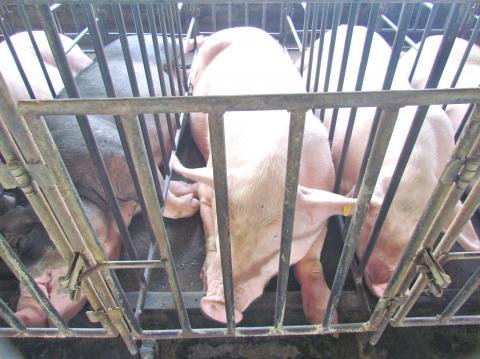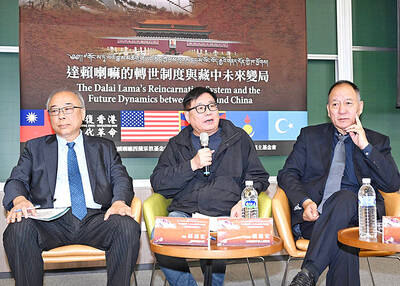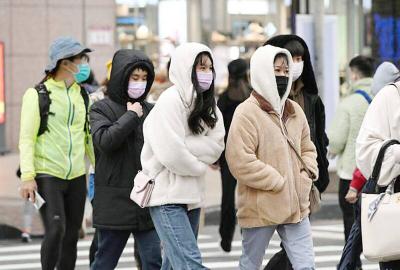Animal rights advocates on Wednesday urged the government to completely ban the practice of confining female breeding pigs to sow stalls, or gestation crates, after they are mated or artificially inseminated, saying that the Council of Agriculture (COA) should set goals on when and how the inhumane treatment of pigs could be eliminated.
The Environment and Animal Society of Taiwan (EAST) held a news conference in Taipei to highlight the plight of about 600,000 or so breeding sows in Taiwan on the eve of Mother’s Day, which falls on Sunday this year.
While women can move around freely and request maternity leave, sows are imprisoned in stalls throughout their pregnancy and are treated as permanent breeding machines, the society said.

Photo: CNA, provided by Environment & Animal Society of Taiwan
EAST director Chen Yu-min (陳玉敏) said that pig farmers would lock breeding pigs in stalls and prepare them for artificial insemination when they turn seven months old and become sexually mature.
After becoming pregnant, the sows then spend the next four months being confined in stalls until just before they deliver their piglets, she said.
A sow stall is about 2m in length and about 0.6m in width, and is only big enough for a pig to stand and lie face down or one side, Chen said, adding that it has no room for pigs to move forward or backward, so that some sows even have to sleep in their own feces.
Breeding stalls are particularly brutal for bigger breeding sows, Chen said.
As they grow bigger during pregnancy, they not only experience the discomfort caused by their bodies pressed against the metal rails of stalls, but their skins can become irritated and swollen or even start to rot because of the constant friction between their skins the metal, she said.
A few days before they are about to give birth, pigs are relocated to farrowing crates to deliver piglets and nurse them, Chen said.
Movement is also restricted in these crates, she added.
“On average, breeding sows get pregnant 1.5 to 2.4 times per year and deliver eight to 12 piglets with each pregnancy. When their fertility starts to decrease, they are sent to the slaughterhouse. You can say their lives are spent between gestation crates and farrowing crates while giving birth continually to piglets in small and narrow places,” Chen said.
Data from the society showed that each Taiwanese on average consumes 38kg of pork per year, 90 percent of which comes from local pig farms. The nation has 7,609 pig farms, raising approximately 5.44 million pigs. About 600,000 of these are breeding sows.
Despite scientific studies showing that the use of breeding stalls affects pigs’ physical and mental health, only 10 pig farms have abandoned the practice, the data showed.
The society pointed to a 2009 study published by former Department of Animal Industry director Hsu Kuei-sen (許桂森), which showed that breeding pigs in Taiwan produce on average 14 pigs that can be sold, which is significantly lower than in the US (20 pigs) and Denmark (22 pigs).
At the same time, the cost of raising pigs is 1.7 times to 1.8 times higher in Taiwan than in the US or Canada, while the survival rates of growing-finishing pigs have been between 68 and 72 percent in recent years, which is also lower than the US (82 percent), Australia (81 percent) and Denmark (80 percent), the society said.
Global efforts to abolish or impose limits on the use of sow stalls since the 1980s have shown results, the society said, as Sweden abolished breeding stalls in 1988 and the UK banned the use of sow stalls in 1999, except seven days before delivery and the day that piglets wean from their mothers.
The EU also banned the use of sow stalls in 2013, but they are permitted during the first four weeks of a pig’s pregnancy, whereas the New Zealand has completely banned the practice, it said.
COA Animal Protection Section chief Jiang Wen-chuan (江文全) said that draft guidelines on pig-friendly production systems are scheduled to be published in September for farmers’ reference.
The guidelines would recommend that pig farmers stop using breeding stalls, he said.
“Breeding stalls have been used in the US and Europe for decades. They were considered the most cost-effective way to breed pigs, preventing mothers from crushing and killing the piglets. With global awareness of animal welfare on the rise, we hope that pig farmers can gradually change their methods,” he said.
As the cost of altering production processes would be high, Wang said that authorities would raise awareness among pig farmers and offer assistance to those willing to change their breeding methods.

ALIGNED THINKING: Taiwan and Japan have a mutual interest in trade, culture and engineering, and can work together for stability, Cho Jung-tai said Taiwan and Japan are two like-minded countries willing to work together to form a “safety barrier” in the Indo-Pacific region, Premier Cho Jung-tai (卓榮泰) yesterday said at the opening ceremony of the 35th Taiwan-Japan Modern Engineering and Technology Symposium in Taipei. Taiwan and Japan are close geographically and closer emotionally, he added. Citing the overflowing of a barrier lake in the Mataian River (馬太鞍溪) in September, Cho said the submersible water level sensors given by Japan during the disaster helped Taiwan monitor the lake’s water levels more accurately. Japan also provided a lot of vaccines early in the outbreak of the COVID-19 pandemic,

Kaohsiung Mayor Chen Chi-mai (陳其邁) on Monday announced light shows and themed traffic lights to welcome fans of South Korean pop group Twice to the port city. The group is to play Kaohsiung on Saturday as part of its “This Is For” world tour. It would be the group’s first performance in Taiwan since its debut 10 years ago. The all-female group consists of five South Koreans, three Japanese and Tainan’s Chou Tzu-yu (周子瑜), the first Taiwan-born and raised member of a South Korean girl group. To promote the group’s arrival, the city has been holding a series of events, including a pop-up

TEMPORAL/SPIRITUAL: Beijing’s claim that the next Buddhist leader must come from China is a heavy-handed political maneuver that will fall flat-faced, experts said China’s requirement that the Dalai Lama’s reincarnation to be born in China and approved by Beijing has drawn criticism, with experts at a forum in Taipei yesterday saying that if Beijing were to put forth its own Dalai Lama, the person would not be recognized by the Tibetan Buddhist community. The experts made a remarks at the two-day forum hosted by the Tibet Religious Foundation of His Holiness the Dalai Lama titled: “The Snow Land Forum: Finding Common Ground on Tibet.” China says it has the right to determine the Dalai Lama’s reincarnation, as it claims sovereignty over Tibet since ancient times,

Temperatures in some parts of Taiwan are expected to fall sharply to lows of 15°C later this week as seasonal northeasterly winds strengthen, the Central Weather Administration (CWA) said today. It is to be the strongest cold wave to affect northern Taiwan this autumn, while Chiayi County in the southwest and some parts of central Taiwan are likely to also see lower temperatures due to radiational cooling, which occurs under conditions of clear skies, light winds and dry weather, the CWA said. Across Taiwan, temperatures are to fall gradually this week, dropping to 15°C to 16°C in the early hours of Wednesday